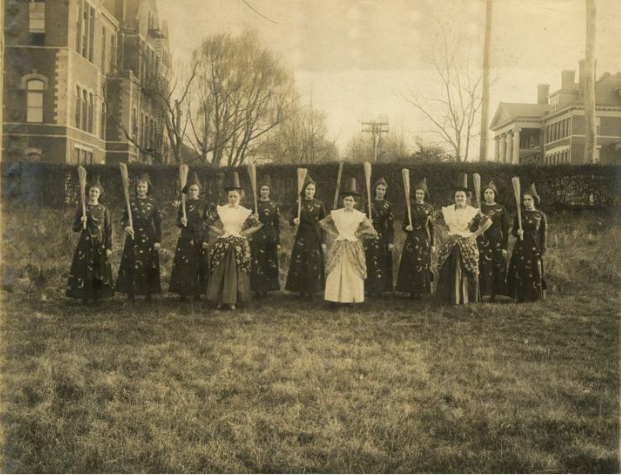For the first fifty years, The University of North Carolina at Greensboro (UNCG) celebrated May Day. May Day revels were based on ideas of Renaissance England, where the first day of May signified the end of winter. Traditional May Day fetes were filled with activities such as decorating a May Pole, crowning a queen, and playing games. The campus festivals of the State Normal and Industrial College (now UNCG) were similar, especially in the early years when elaborate May Day events were held every four years.
The school’s May Day fetes of 1912 and 1916 were more extravagant than their successors. Tickets were sold, and there were announcements and advertisements in newspapers across the state. The entire campus was decorated, from the athletic field (now Petty Science Building) to Peabody Park. Special programs were created, detailing the five continuous hours of entertainment as well as the parade route. Students performed shows such as “Hue and Cry after Cupid,” “Robin Hood,” and “A Midsummer Night’s Dream” in different parts of campus.
The beginning procession introduced onlookers to the festivals and kicked off the largest May Day celebrations of 1912 and 1916. It featured decorated floats and included most of the costumed participants. The parade route started in downtown Greensboro and continued down College Avenue to the athletic field. In the 1916 festival, the parade traveled from the north end of College Avenue and continued south, moving past the Students’ Building, the Main Building (now Foust Building), and the McIver Memorial Building. Heralds began the parade, appearing before the actors and dancers. Shepherds and shepherdesses, milkmaids, and other costumed students walked beside the floats, which were ornately decorated and exemplified the Renaissance theme. The May Queen, elected by fellow students and the “mascot” of the event, arrived on her own float with her king by her side. Players from the different tableaux rode and walked in the procession, and the May Queen had her own float. Spectators from all over the state stood along College Avenue to watch the decorative floats and costumed performers.
Processions also occurred at May Day fetes in the following years, though never as large as those of 1912 and 1916. There were parades in the 1920s and 1930s, but they had shorter routes through campus and less extravagant floats. Perhaps, World War I contributed to the fact that the later festivals were not as elaborate. Eventually, the parades came to an end; perhaps because the celebrations were smaller or were too expensive to continue.
This blog was created by Jennifer Brooks, volunteer at the Martha Blakeney Hodges Special Collections and University Archives, April, 2015.


